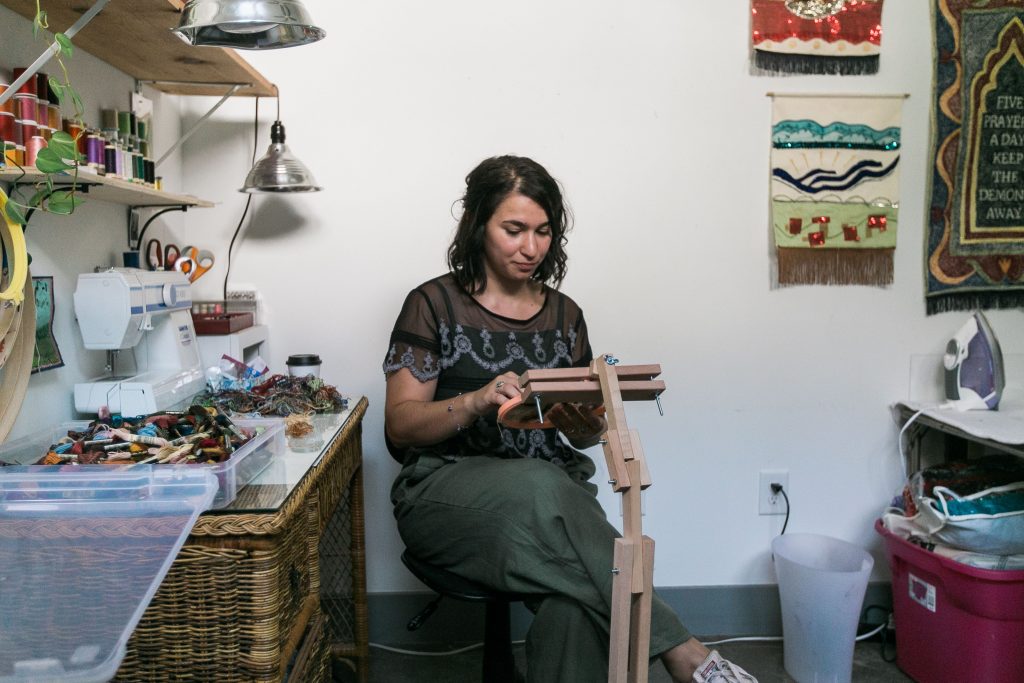
Beizar Aradini is a local artist specializing in fiber, textile, and sculpture work. Her pieces explore her family’s status as Kurdish immigrants while challenging the place and meaning of “domestic” objects and crafts. Since graduating from MTSU in 2017, Aradini has shown as a solo artist at Swine Gallery in Chattanooga, and as part of group exhibits at Mason Fine Art in Atlanta, Casa Azafran, and Cummins Station. She is currently one of the featured artists at Julia Martin Gallery’s Bevy 2018, and she recently—in collaboration with youths from The Oasis Center—made a quilt that was unveiled at The Frist on World Refugee Day. We talked to Aradini about her work, her culture, and how to survive in today’s America.
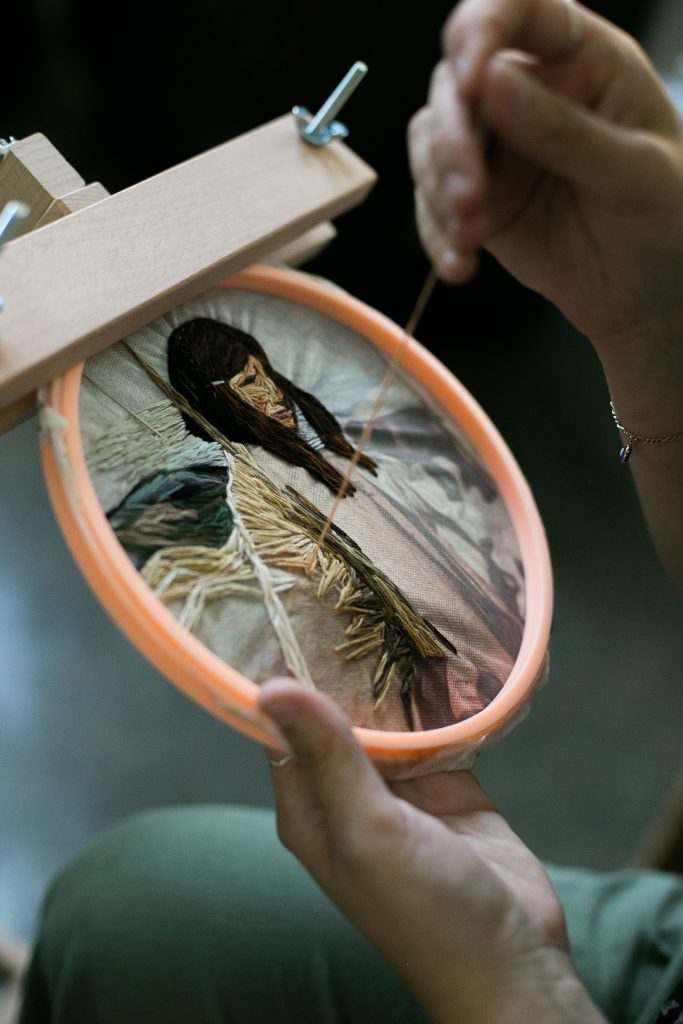
Working with fibers, textiles, and even hair is a difficult, tedious, and time-consuming process. Do you think there’s a metaphor to be drawn between you working in a difficult medium and the difficulties you and your family faced when coming to the US?
These processes seem most familiar and natural to me. Growing up, my mother was always tinkering around with her sewing machine while watching me and my six siblings. I’ve always had an appreciation for things that take time to make—there’s a sense of preciousness or quality to handmade things.
I don’t think I could ever grasp the challenges my parents endured, but perhaps this is a way for me to understand that difficult things and challenging times require a lot of attention. Patience and caution were daily necessities for my parents as they fled Iraq on foot.
Your parents fled from northern Iraq to escape the Hussein regime. Four years after they fled, you were born in what you describe as “a refugee tent draped with layers of torn and worn out fabrics amidst the jagged and uncertain brown peaks of southern Turkey.” Do you create domestic objects in an attempt to find a sense of home or identity after your family’s displacement?
Totally. I’ve learned that the idea of home isn’t confined to one place. Nashville has always felt like “home” to me, but my biological identity has never felt completely connected. I grew up in a household where everything was completely decorated in a Kurdish aesthetic. Everything was curated to the Kurdish lifestyle, from a television with an international satellite broadcasting Middle Eastern news to having a garden flourishing with all the right herbs and vegetables available to make any Kurdish cuisine. When you’re growing up in these circumstances—even when you’re fully emerged into something so beautifully cultured—there’s still a desperation of wanting to be accepted while being in-between these lifestyles. Maybe to sum up, displacement means having many homes while simultaneously having no home.
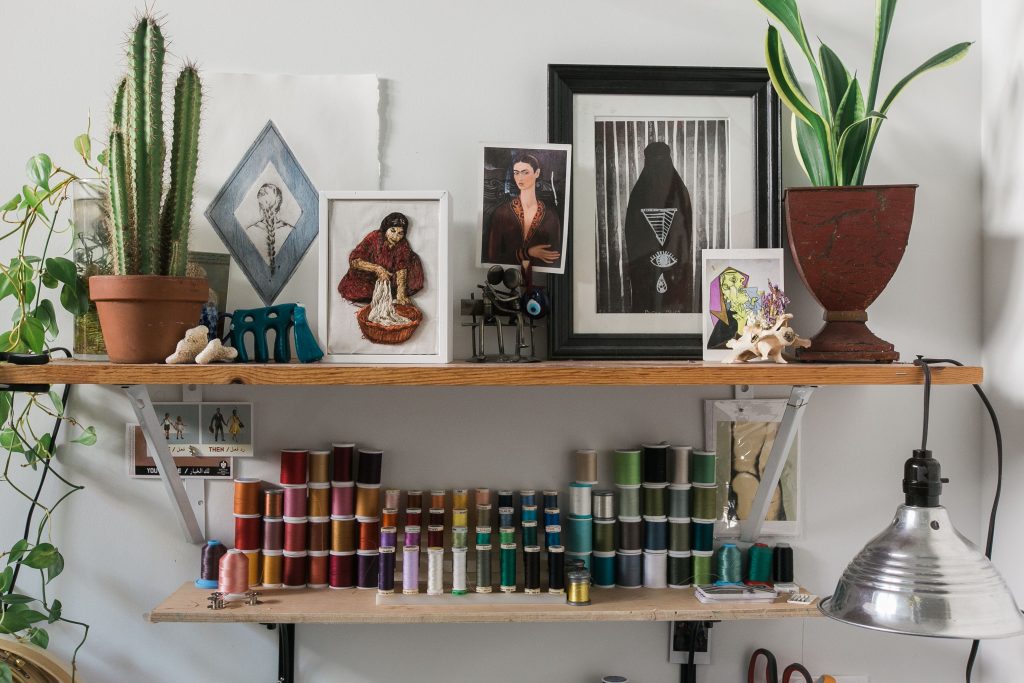
Your work recontextualizes and distorts our ideas about traditionally “feminine” work—in this case knitting, sewing, and embroidery. How does your heritage and your family’s backstory affect this recontextualization? Do you think it makes the work that much more subversive?
In my culture, artwork is mainly seen and depicted through craftwork such as tapestries and woven rugs. A lot of these objects are made out of necessity or as a leisure activity but rarely exhibited as “fine art.” Many of these rugs and tapestries represent the maker’s story through the use of symbolism. There’s a common language in crafts; these skills have been used for centuries across so many different cultures to tell stories, whether it’s making quilts or embroidering. I want to challenge these traditional ideas of craft and also of fine art within my Kurdish culture. It’s a way I could share my story but through similar processes my ancestors would have.
Though they’re “domestic” items, there’s a certain warped quality to your work—you could maybe even say it’s haunting.
It reflects the true nature of the “immigrant’s experience.” You’re forced to leave your country because of a war your people never asked for, or to escape a regime chemically gassing and oppressing your people from speaking their own language. Then, you’re accepted into a new country—practically a whole new world—where you are constantly being ridiculed for your appearance, culture, or subtle differences. My parents didn’t have a choice. As grateful as they are for their lives here in America, I’m sure they wouldn’t have left their own homeland and families to deal with such isolation. It’s like a paradox. As immigrant children being raised in such diaspora, it’s not easy to abide by two entirely different sets of cultural and social expectations.
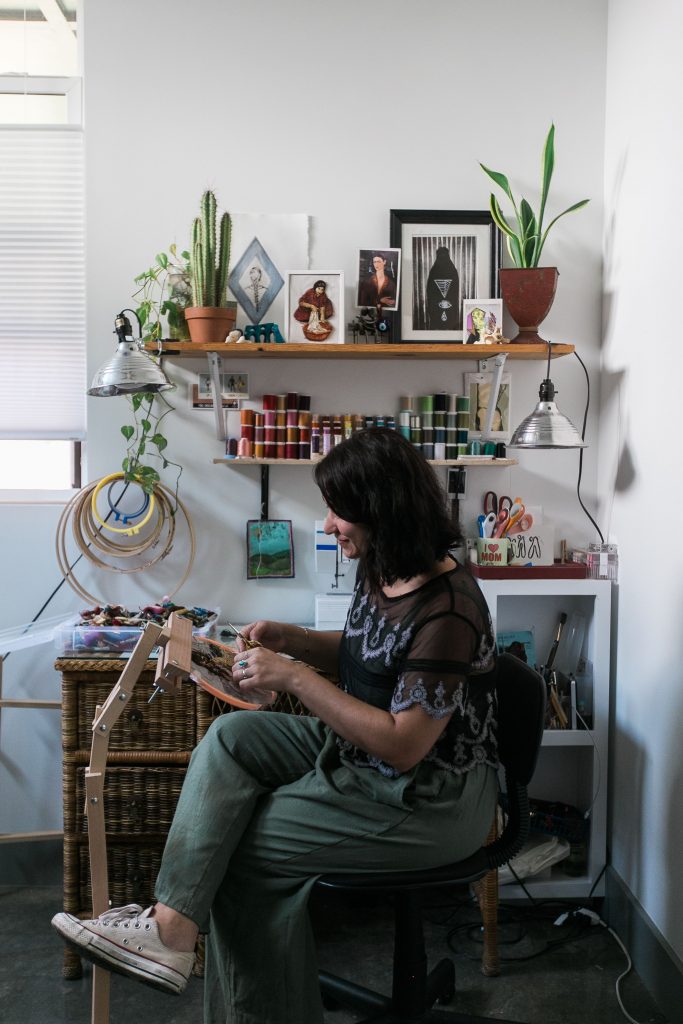
Does your work aim to humanize people—and remind Westerners that refugees are, in fact, people—in an age where our president describes immigrants as “animals” and whole nations as “shitholes”?
It’s hard to digest the reality of our political climate, but I try to stay hopeful and think that Trump is not a complete representation of our nation. Through stories I’ve been told by my parents to the stories of these individuals seeking asylum, [I’ve learned that] they have struggled through such harsh situations some of us couldn’t bear to live through for just one day. Coming into this or any country to seek refuge should not be a degrading experience.
Through a lot of embroidered work, I try to depict my family’s journey coming to America. The embroidered portraits I make are mostly from photos my parents discovered just recently from a family friend that was also placed in the same refugee campsite in Mardin, Turkey. When my parents left Kurdistan, they left with the bare minimum to be able to escape safely. These are some of the only photos I’ve ever seen of my parents at a younger age. These photos are also of my parents trying to survive at such a difficult time. When looking at these images, there’s a sense of displacement, but also an optimism to feel human again.
You’ve said you live in a “bicultural reality.” As you get older, how do you reconcile your Kurdish heritage with your American identity? Do you grapple with feeling alienated or like The Other?
As a Kurdish female I “rebelled” and moved out at the age of eighteen to be in a relationship that was not accepted by my community or family. Although this is becoming more normalized and accepted within the community, at that time I felt so lost. Who the hell was I? Without my Kurdish lifestyle and my mother’s incredible naan u mast? I was too Kurdish to be American and too American to be Kurdish. I mean seriously, my Kurdish kind of has a Southern accent.
That being said, feeling alienated comes from both sides. I constantly felt in-between two places I didn’t really know. I’ve grown a lot from this experience and learned to hold onto my Kurdish heritage by creating my own community of Kurdish people all around the world through social media. It doesn’t feel so isolating and I’ve reached out to others that have experienced similar situations.
When I tell people about this experience, though, their initial reaction is “What did your parents think was going to happen when they moved to America?” This does not help in any way. I completely understand and accept my parents’ resilience to hold on to every bit of their heritage that has constantly been oppressed.
As the American political climate gets more turbulent, surreal, and divisive by the hour, I think a lot of people—even people who want to do good—feel helpless or like their efforts are futile. How can the average Nashvillian be a better advocate for local immigrant communities? And in your lifetime, do you think Nashville has become better or worse for immigrants?
Everyone could be a little more understanding and accepting to differences that aren’t ingrained to Western culture. Adjusting to the Western lifestyle is not easy—be patient and give these communities time to adjust to our rapidly changing culture. Even growing up in Nashville, a lot has changed. But I do think our city has become more welcoming to immigrants, and I feel like our city is continuing to make improvements to include these marginalized communities.
Aradini’s work is showing now through July 28 at Julia Martin Gallery.
Suggested Content
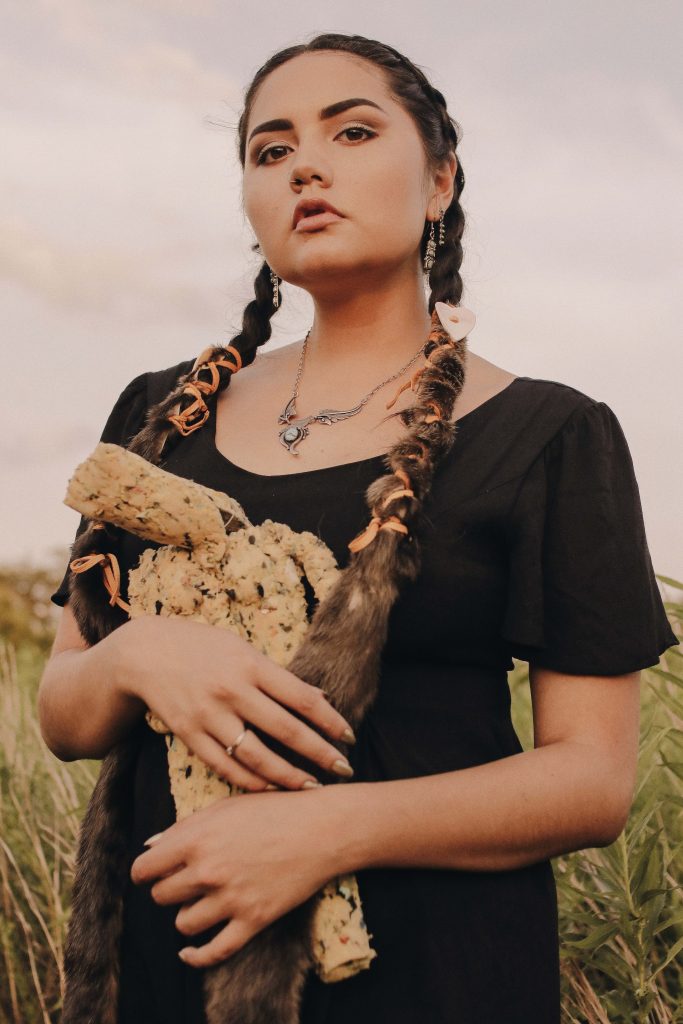
Chelsea Kaiah James
Why aren't there any ears sculpted onto the presidents of Mt. Rushmore? Because American doesn't know how to listen. - Unkown
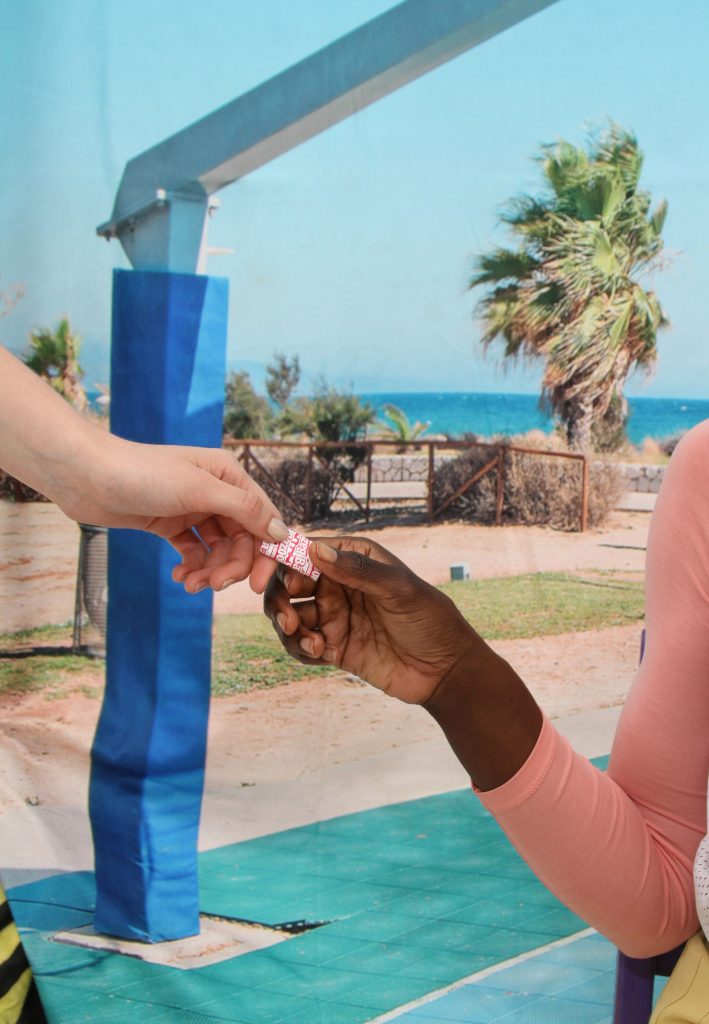
Contributor Spotlight: Dylan Reyes
When I create, I often think of what Johannes Itten said, “He who wishes to become a master of color must see, feel, and experience each individual color in its endless combinations with all other colors.”. I’m also inspired frequently by love and loneliness and want folks consuming my work to be encouraged to start paying attention to the little details in everyday life, appreciate the simple things, and let them eventually inspire you! Ultimately, I’m just trying to become a mother fuckin master of color.
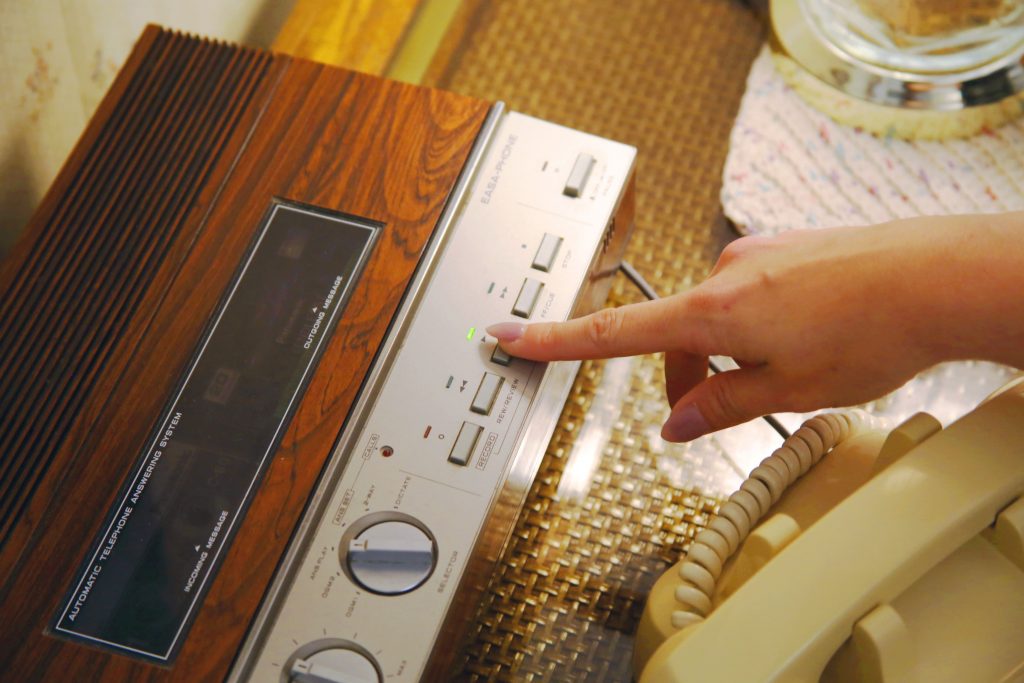
Secondhand Sorcery
A look inside the beautifully cheesy world of Crappy Magic
